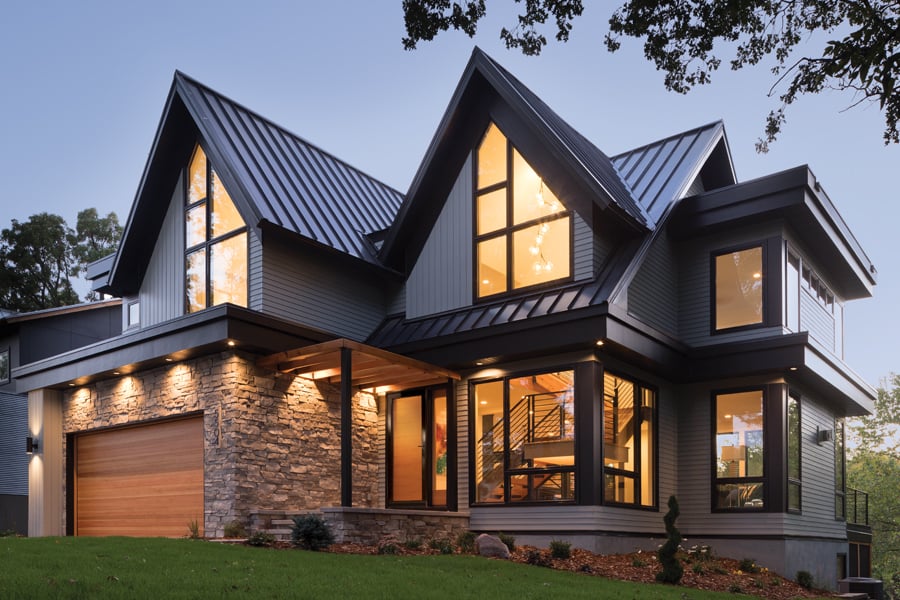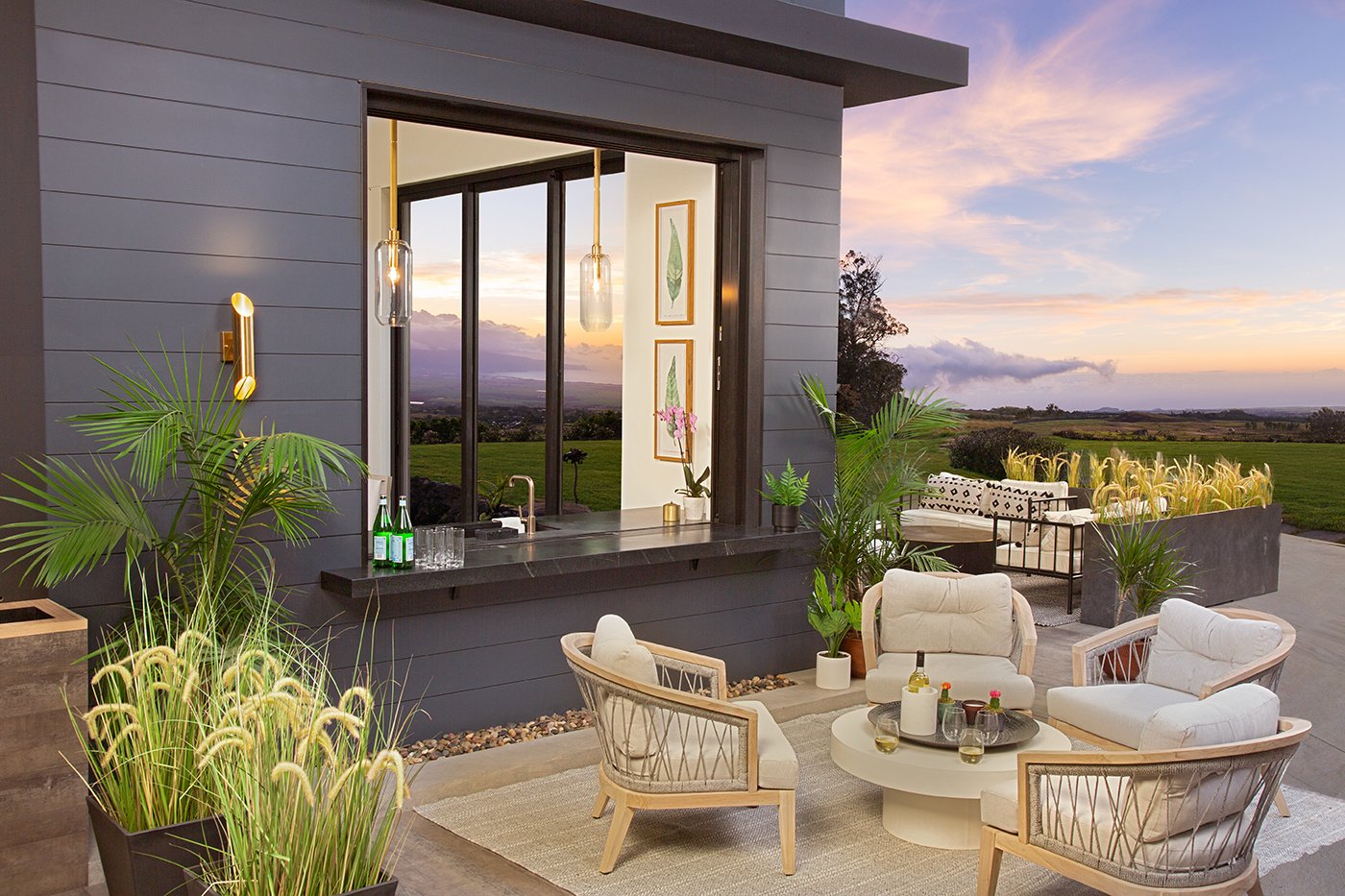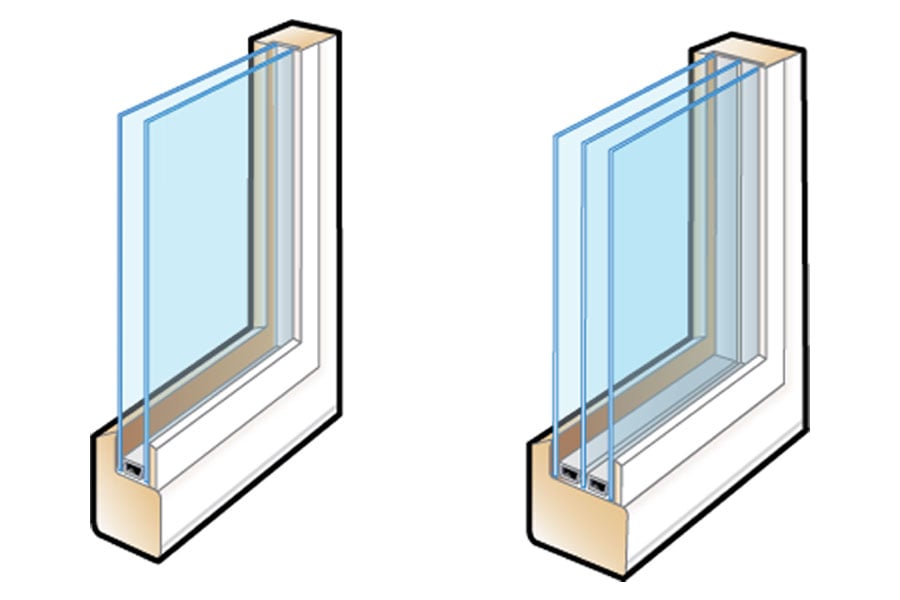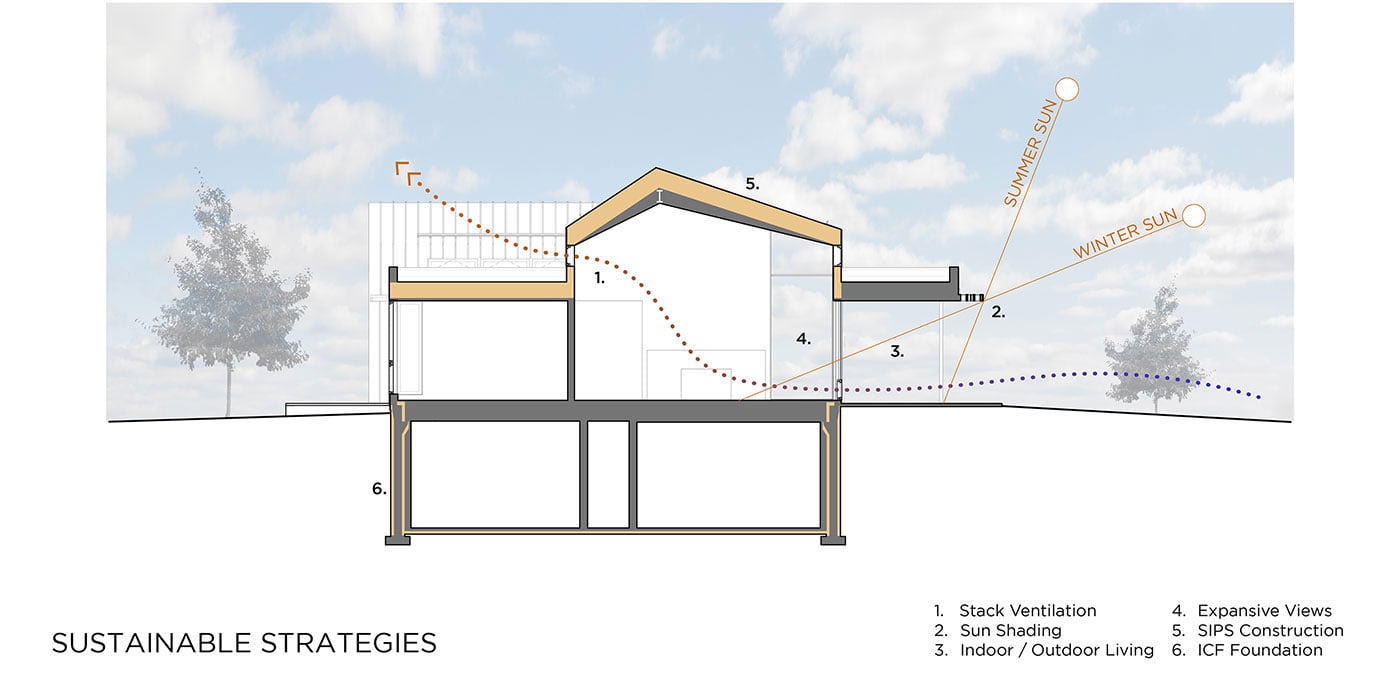Tips
How to choose windows for your new construction home or remodel

Window styles 101: What to know about each type
Window styles, or as we call them, window types, describe how a window opens (or operates). Here’s a quick overview of the types of windows we offer.
Popular window styles for new homes and how to choose them
| Window type | Home styles | Pros | Cons | What else to know |
|---|---|---|---|---|
|
Double-hung windows have two sashes that slide to open both from the top and the bottom. |
Find double-hung windows in all styles of traditional homes, including these popular styles:
|
There are two opportunities for air flow so you can open top, bottom, or both. When both top and bottom sashes are open, circular ventilation is possible — hot air flows out the top, and cool air flows in the bottom. These windows are classic, so they suit any style of home, but particularly more traditional styles. |
With more moving parts and pieces, double-hung windows can be more expensive than some other types of windows. |
Some people like double-hung windows on the first floor or in a child’s bedroom because of the option to open the top sash. Double-hung windows are available through all our product lines. |
|
Single-hung windows look identical to double-hung windows but differ in a fundamental way. Only the bottom sash opens by sliding up. |
Anywhere a double-hung window might be found, a single-hung window will work too since they look identical. One thing to note is that we only offer single-hung windows through our 100 Series product line, which has a more modern aesthetic. If you’re creating a transitional home, think Modern farmhouse, Modern Tudor, and similar, the 100 Series single-hung window could be the perfect choice. |
Get the classic look of a double-hung window with improved energy-efficiency. This is due to the fixed (doesn’t open) top sash. Compared to a double-hung window, a single-hung is less expensive because it requires fewer parts and pieces. This can also simplify maintenance down the road.
|
There’s only one opening, so there’s less opportunity for air flow into the home. |
In places where the top sash is too high to reach, a single-hung window can be a practical choice. Single-hung windows are available through our 100 Series product line. |
|
Casement windows have a single sash and open outward with a crank. |
Casement windows are an unbeatable pick for a modern home, especially these popular styles:
They can work equally well in certain traditional home styles, including:
|
Casements are the most energy-efficient of the operable (opening) windows we offer. Get a more modern look with the sleek single-sash design of a casement window. |
These windows open outward, so they might not be the best choice next to a walkway, deck, or porch. In these places, they can impede movement or reduce the amount of usable living space. |
Above a kitchen sink or anywhere you’d have to reach to open the window, a casement is easy to operate. Casement windows are available through all of our product lines. They can be ordered with a simulated checkrail, which makes them look like double-hung windows. |
|
Picture windows are windows that don’t open at all. |
Picture windows play nice in any style of home. You’ll often find them in oversized form in modern homes and more moderately sized in more traditional homes. |
Picture windows are the most energy efficient windows because they don’t open. Picture windows can be extra large due to their inoperability.
|
They don’t open, so typically they make the most sense in spaces where there are doors or other windows that do open. |
A popular choice in living rooms especially when paired with a double-hung or casement on either side. They’re also the type used to create floor-to-ceiling windows. Picture windows are available through all our product lines. |
|
Bay windows are combination units that project beyond the walls of a home and feature a picture window at the center and either casement or double-hung windows on the sides. |
Bay windows are classic in several popular traditional home styles, including:
|
Dramatic and eye-catching, these windows add character to a home. With three windows in one that project beyond the walls of your home, you get extra airflow, space, and panoramic views. |
Bay windows benefit from extra insulation at the header and footer. Proper installation is especially key when installing this type of window. |
Bays are a popular choice in living rooms where they can make a statement, as well as bedrooms. Bay windows are available through our 400 Series and E-Series product lines. |
|
Bow windows are a variation on a bay that include a combination of casement windows arranged in a gentle curve that projects beyond the walls of a home. |
This spin on a bay window suits a variety of traditional home styles. |
Like a classic bay, bow windows are statement makers. With a minimum of four windows, they add extra airflow, space, and panoramic views. |
Proper installation of window combination units, including bows, requires attention and careful planning. |
Bows are a popular choice in living rooms and other more public rooms in the home where their statement-making good looks can be fully appreciated. |
|
Gliding windows include two or three sashes that are horizontally oriented and slide to open. |
Gliding windows are a nice choice for more modern styles, think:
|
They fill a large space efficiently; a gliding window can even include three sashes. With fewer parts and pieces, it can require less maintenance over time. |
Gliding windows can operate in various ways. Some only open on one side, so it’s important to think through how you'll use it before you order. This isn’t a detail that can be changed later. |
Gliding windows can be a good choice adjacent to a porch or deck because they open flush, so they won’t impede movement in your outdoor space. Gliding windows are available through our 100 Series, 200 Series, 400 Series, and E-Series product lines. |
|
Awning windows are single-sash horizontally oriented windows that are hinged at the top and open out and up. |
An awning window is another good choice for a more modern home, like:
|
Similar to casements, awnings are one of the most energy-efficient operable windows. Their single-sash design gives them a more modern look. |
With their outward opening, they aren’t the best choice next to walkways, decks, or porches where they can impede movement and reduce usable living space. |
Awnings are a popular choice in bathrooms where they’re often placed higher on the wall for privacy. They can also be ordered with a power operator, which allows opening at the touch of a button. Awning windows are offered through our 100 Series, 400 Series, A-Series, and E-Series product lines. |
|
Specialty windows come in the most popular non-standard shapes and are mostly fixed (don’t open). |
Specialty windows can complement any style of home. However, certain shapes are associated with particular home styles, like arches in Spanish-style homes, for example. |
Add a signature feature to your home with a circle, arch, trapezoid, or other unique window shape without placing a special order. Combine non-standard shapes for a large-scale window unit. |
Specialty windows are mostly fixed (don’t open), but some can open. |
Sometimes, several specialty windows are combined into a large-scale window combination unit to fill a wall. Specialty windows are offered through the 100 Series, 400 Series, A-Series, and E-Series. |
|
Pass-through windows are windows that are meant to facilitate indoor/outdoor entertaining and come in a range of opening styles. |
These windows go best in homes that have well-defined outdoor living spaces. Selections are flexible so you can match your home style. |
More than any other window, pass-through windows are about enabling a certain lifestyle. If you live to entertain and want to make the most of your outdoor living space, this window is made for you. A large opening can be created with a pass-through that makes it easy to pass out food, beverages, and create an open-air atmosphere in your home. |
Pass-through windows are smaller versions of our oversize patio doors, which are premium products with a price to match. A flush to countertop install is the ideal and can be accomplished with water management included, but it’s a complex installation that requires proper planning and will likely be more expensive when compared to installing a more standard type of window. |
Pass-through windows are typically installed at counter level between a kitchen and outdoor living space where they can make it easy to use both spaces at once. We offer Folding Outswing Pass-Through Windows, MultiGlide™ Pass-Through Windows (this option can pocket and automate), and Liftslide Pass-Through Windows. |
3 things to know about windows in a new construction home
Windows are a big deal. We don’t just say this because we’re a window manufacturer; we say this because they differ significantly from most of the other materials that go into a standard new build. Keep these things in mind:
1. New construction windows are custom
Think about the “bricks and sticks,” as the industry expression goes, that make up much of your home. Those materials are readily available at a building supply store. The windows and doors, though, due to their size, color, hardware, and other details, selected by you and your team, are much more customized. What this means in practice is that they should be ordered early in the process, so the lead time to make them according to your specifications doesn't slow down the building process.
TIP: Sometimes ordering windows primed and then finishing them on site is a smart move. This means you can order your windows even if your interior look and finishes are still being planned. Once those decisions have been made, your builder can paint your windows to match the interior design.

2. New construction windows and doors can make indoor/outdoor living possible
Another thing that’s important to consider when planning for windows and doors is indoor/outdoor living. The patio, porch, and poolside are like second living rooms. Large-format doors make for seamless connections between spaces, but these types of doors must be planned for from the start. If your dream includes a moving glass wall that blends your indoor and outdoor living spaces into one, the sooner you share this with your architect, the better the whole team will be able to plan and execute.
TIP: In addition to our Big Door options of Folding Outswing Doors, MultiGlide Doors, and Liftslide Doors, we offer pass-through windows. These windows are scaled-down versions of our big door products, ideal for connecting kitchens with outdoor living spaces for easy entertaining! And when a Big door isn’t in the budget, there are ways to expand the size of a hinged or gliding patio door with additional panels, sidelights (windows on the side), and transoms (windows above the door).

3. New construction windows can come with less framing
We all want to bask in light from large, beautiful windows. One option that homeowners aren’t always aware of is that joined windows allow for more glass overall. These windows are designed to connect to one another without the need for wall framing in between. This allows for the creation of large window units and even window walls. However, installing these types of features is something that a builder will need to plan for when framing the walls. It’s also a detail that’s specified when your windows are ordered. So again, the earlier you communicate your vision, the better.
TIP: Our Easy Connect joining system allows for windows and doors to be joined to create large combinations. Easy Connect is available with our 100 Series and A-Series. When ordering your windows, your builder or architect, along with the window dealer, can help guide you in selecting windows that are designed to join.

Window performance and efficiency
Your location is key to determining your performance needs. For example, if you live in a northern climate zone, you might want to use the sun’s energy to help heat your home, while if you live in a southern climate zone, you’ll want to protect your home from the sun.
Believe it or not, your window selections can support these efforts, especially when windows are placed purposefully within a well-designed home. But before we get into window selection details, it’s useful to know a few key measures that are used to assess window performance.
- Solar heat gain coefficient (SHGC) measures how much energy is gained when the sun shines through a window.
- U-Factor measures the rate of energy loss through a window, or how much of the heating or air conditioning from inside the home is escaping through the window.
Both of these measures are used across the industry to assess the performance of windows and doors. You can use these measures to understand what’s recommended for your climate through various programs, like ENERGY STAR®, Passive House, and others with performance standards for windows and doors.
You also don’t have to get this technical in order to pick out windows that will perform well for your location. If there are code-required standards you need to meet in your location or if you’re building a home to meet the performance standards of a program like those mentioned above, your builder or architect will help.
As the homeowner, you’ll want to be aware of the selections you can make to improve the performance of your windows and doors, like these:
- Triple-pane glass is most impactful in the most northerly climate zones. It provides better insulation, which helps keep the air inside your home from escaping and the outside air outside. This is because triple-pane glass includes three panes of glass, two air spaces, and the opportunity for more low-emissivity (Low-E) coatings.
- Low-E coatings are ultra-thin and mostly transparent coatings that reflect energy in a way that helps improve a window’s efficiency. There are a variety of coatings available, and the right coating (or combination of coatings) will depend on your climate. Much of the time Low-E4® glass is the right coating because it helps improve efficiency in all seasons.
- Window types also play a role as some are more efficient than others. Windows that don’t open (picture windows) are the most energy efficient. Of the operable (or opening) windows, casement and awning windows are the best performing.

Window placement and its effect on light and energy use
In the northern hemisphere, light comes from the south. This means that if you want to maximize natural light and use the sun’s energy to heat your home, you’ll want more windows on the south side of your home. While this is a practical approach in northern climate zones, in southern climate zones, it’s more important to protect homes from the sun’s intensity. This can be done by concentrating windows on the eastern and northern sides of the home, incorporating overhangs, and more. The planning of windows and doors is a foundational aspect to designing a home, and it’s one that your architect or designer will be considering.

How to get involved in window selection
Windows and doors are usually specified by an architect during the project's design phase. Architects are familiar with different window manufacturers, and they will be thinking about your home’s style and budget as they’re working on this aspect of the design. Your builder will actually order and install the windows, so they’ll have an opinion as well.
Although your pro or pros will be guiding you, that doesn’t mean you don’t have a role in the decision-making. Here are some ways you can involve yourself in the window and door selection process:
- Communicate any window or door dreams early. Whether it’s a bay window over your kitchen sink or a moving wall of glass, the sooner your architect knows what you want, the better they’ll be able to plan for it. This is especially true when it comes to incorporating a Big Door.
- Ask to visit a showroom together with your architect. Just like you wouldn’t buy a car without test driving it, you’ll want to go see the windows you’re considering before ordering them. Seeing them up close, feeling how they open, noticing their finish, and the quality of their hardware can help instill confidence that you’re making a good decision.
- Speak up if you prefer a specific manufacturer. If you’re an experienced homeowner, you might have learned that you prefer one over another. In that case, there’s no reason to be shy about communicating your preference. You are the client.
TIP: Your pros have the experience of specifying and installing windows and doors on every single project. Their knowledge and expertise is valuable, but it doesn’t mean you should take a backseat on this decision. You will be living with your windows and doors every single day. The way they look, and their function should align with your preferences and needs too. Good pros will help you find the product that furthers the design of your home, provides the right level of performance, fits your budget, and makes you happy.
Window costs for a new construction home
Everyone wants to know how much their new windows will cost, understandably so. However, the answer isn’t something that can be generalized. The cost of your windows will depend on the specifics of the products you select: quantity, size, product line, and features. It will also depend on your location, as installation costs include labor, another variable. Additionally, local code requirements can impact window selections.
Still there are a few things you should know about the cost of windows for a new construction home or major remodel:
- Purchasing more windows can lead to greater savings. It’s kind of like how buying 5 pounds of lemons at Costco might be cheaper than buying 1 pound at your regular grocery store. Since you are purchasing more of the product, you might benefit from a deeper discount. This is something that will be determined by the retailer or dealer where you purchase. We don’t sell directly to customers.
- Materials are a major differentiator between our product lines affecting cost. While all our product lines must meet the quality standards set by our industry and the ones we set for ourselves, using different materials allows us to offer product lines at various price points. Starting with our most affordable 100 Series product line, which is made of our exclusive Fibrex® material.
- “New construction” windows or flanged full-frame windows are the type of windows used in new homes or major remodels where the windows are installed before siding and trim. These types of windows are easier to install and easier to connect with the drainage plane — without getting too technical, just know this is about keeping water out of your home. So while these windows might not save you money upfront, they could save you money in the long run by performing in a way that protects your home from the elements.
Your builder and architect will be your guides as you delve into the design and construction of your project.
Gain an understanding about the major factors related to window and door costs or request a quote, if you’re ready for the details needed to begin budgeting.
How long will new windows last?
As you’re shopping for windows and comparing offerings from different manufacturers, one way to understand longevity is to compare warranties. How long is the manufacturer willing to stand behind their product? In our case, the answer is decades. No matter the product line you select, we manufacture for the long-term. While the exact details vary by product line, here’s what to expect from our limited product warranties:
- 20 years on standard glass
- 10 years on non-glass components
- 2 years on installations performed by Andersen Certified Contractors
- Fully transferrable warranties from one owner to the next
Find more details about our warranties.
Window maintenance at a glance
One way to help your windows stay in top condition for years to come is by caring for them regularly. Regular is the keyword as it helps keep the tasks manageable and helps you notice potential problems before they become major, or even irreparable issues. Here’s our quick checklist for maintaining windows:
- Wash windows twice per year, once in the spring and again in the fall.
- Remove, clean, and store insect screens before winter to avoid unnecessary wear and tear.
- Winterize your windows by checking their weatherstripping, looking for signs of decay on the exterior, and taking a few other steps.
Simple tasks like these will help keep your windows looking good and functioning well in the long term.
Your new construction window FAQs answered
How long do new windows last?
The manufacturer’s warranty is a good way to understand how long they’re willing to stand behind their product, but it’s not like an expiration date. Although our limited warranties are for 20 years on standard glass and 10 years on non-glass components (with exact details varying by product line), windows can and do last for longer. In fact, we’re still manufacturing replacement parts for windows originally manufactured many decades ago.
Why is condensation forming on my new windows?
The building materials used in new construction produce a great deal of moisture. We’re talking about wood, plaster, cement, and other materials. When the heat is turned on, you may notice condensation on your new windows due to these materials. This type of condensation on new construction windows is not a sign of window failure, and it should disappear over the course of your first winter in your new home.
Are new windows a good investment?
Absolutely! Windows are a part of your home’s building envelope, which includes roof and wall assemblies, foundation and all the components that protect it from the elements. High-quality windows make your home more comfortable by keeping conditioned air inside and the elements outside. They’re one of the most important components in your home for this reason and lots of others. Windows connect us to nature by framing views, bringing in fresh air, and filling our homes with feel-good natural light. They’re also not as easy to replace as lighting, countertops, paint and other finishes. Investing from the start in good windows pays off long-term. It's the enduring truth in one of our most famous taglines of old, “Only the rich can afford poor windows.”
